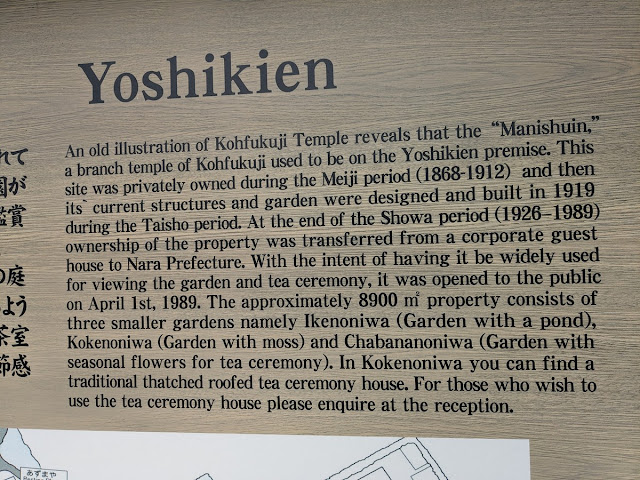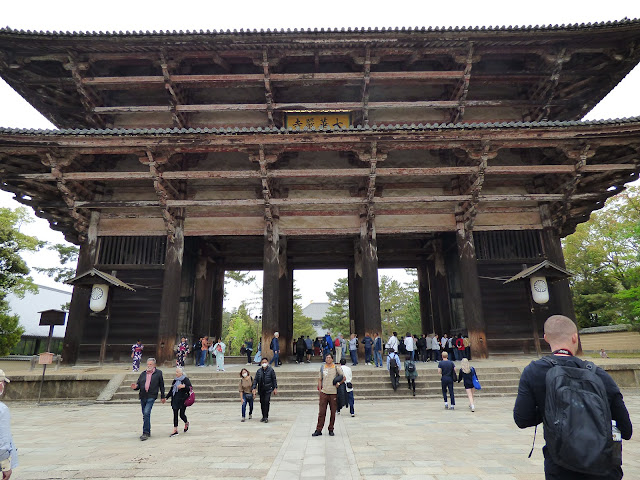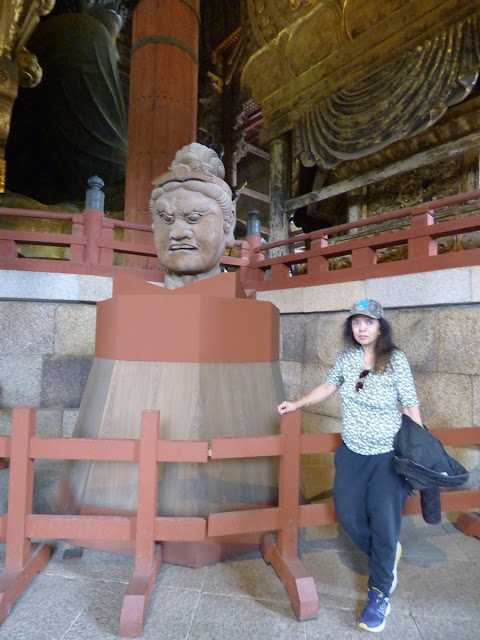DAY 7, Apr 18 Thurs 2024:

Nara day trip [ Isuien Garden, Neiraku museum, Yoshikien garden, Todaiji temple Daibutsuden (Big Buddha Hall)]
OUR DAY TRIP LOGISTICS AND WHAT WENT WRONG
There are two companies running trains from Kyoto to Nara: JR East and Kintetsu, the JR station in Nara is further away from the temple, so we decided to take the Kintetsu Limited Express.
All our important destinations and the train stations are marked in red circles in the map below.
Both the temple and the gardens open only at 9:00 AM so we decided to have a relatively late start. there are world class gardens there. we were hoping to see the gardens first and then walk to the temple
We were careful not to buy the JR tickets because the JR Station at Nara is not convenient for walking to the shrine, it is further away than the Kintetsu Station. The Kintetsu is also a little lower priced and equally fast though it is not an express like the JR.
It was supposed to be a direct train but we were asked to transfer. We made a mistake, thankfully we didn't get punished or fined.
The details are as follows.
For our Nara day trip from Kyoto we bought the ticket for the direct line Kintetsu at the ticket kiosk in the station. The staff member gave us a bunch of tickets. We were supposed to get one ticket but the kiosk member gave us two tickets each. When we asked him he said we had to get down at an earlier station Yamatosaidaiji and take the next train from the same platform for two more stops to Nara, it will be quite simple.
So we got down at the Yamatosaidaiji station he specified, stood on the same platform and saw on the electronic board the train to Nara was coming in two minutes. A train came up in a minute, we got in. We started looking at the stations it was stopping at but Nara was not coming. We realised we were on the wrong train and got out at the next station. By then we had travelled some six stations away.
We asked local youngsters standing in line at the station how to get to Nara from there, they consulted their phone and told us to go to platform 5 or 6 and take the next train to Yamatosaidaiji. So we backtracked and reached Yamatosaidaiji.
Now we just had to take the train to Nara, the kintetsu train. And Nara Express came in a minute and we got in, reached Nara the next station.
We realised we had made another mistake and taken the Jr Express for which we did not have ticket. They are two different companies and we had taken a free ride. Our kintetsu ticket was not getting recognised at the JR gates and we were unable to get out.
We approached the JR staff, showed him our tickets and explained we had taken the wrong train at Yamatosaidaiji, the man was kind and buzzed us out, probably because we were dumb tourists, had not tried to cheat the system but made a genuine mistake; it was very kind of him.
This put us in the JR station which we had tried to avoid but we were anyway grateful for reaching Nara. We took the local bus and got down at the Isuien gardens instead of travelling to the shrine, so anyway we were able to handle our mistake and the rest of the day went smooth.
Isuien Garden
Todaiji Temple's Nandaimon Gate and Mount Wakakusayama seen in the pic below is "borrowed scenery" adding to the beauty.
water mill
MUSEUM:
Yoshiki-en (吉城園)
Tōdai-ji (東大寺, Todaiji temple [738 CE]
Nandaimon (Great South Gate)
Tengai-mon
DEERS
Tame sika deer (also known as spotted deer or Japanese deer) roam through the town, especially in Nara Park. begging for shika senbei, special crackers for deer that are sold for 200 yen.Todaiji's main hall, the Daibutsuden (Big Buddha Hall)

Dimensions of the Daibutsu [BIG BUDDHA]
This is Koumokuten whose piercing eyes see through evil
Yakushi Nyorai... Healing Buddha:
Tōdai-ji Museum
Then we dodged the aggressive deers and walked to the Nara National Museum.
Nara National Museum
There are these lovely demos of how wooden statues are made with all the different stages. The different mudras hand gestures of Buddha are also explained
We had our picnic meal with us but really had to put a distance from the numerous deers which were hungrily nosing around for food. We walked to the kintetsu train station, on the way, we had our sandwiches.
NARA KINTETSU TRAIN STATION
We had made plans to get down at Uje but decided we were too tired for that. We bought tickets direct to Kyoto on the limited express and went to our apt
We had bought this ice cream three cups of chocolate flavour and three cups of green tea. Both were just so so.
we wound up for the day.
















































































No comments:
Post a Comment